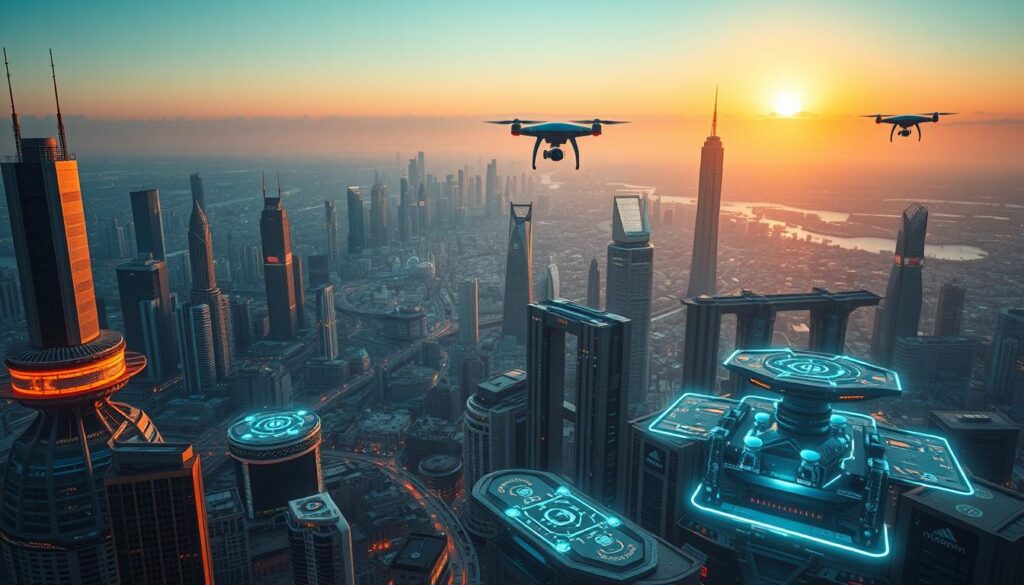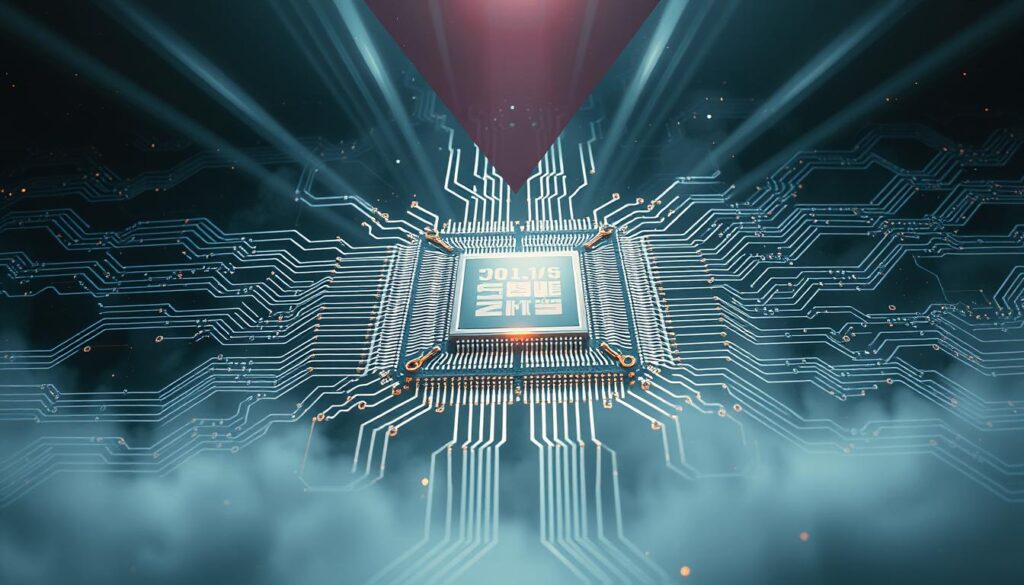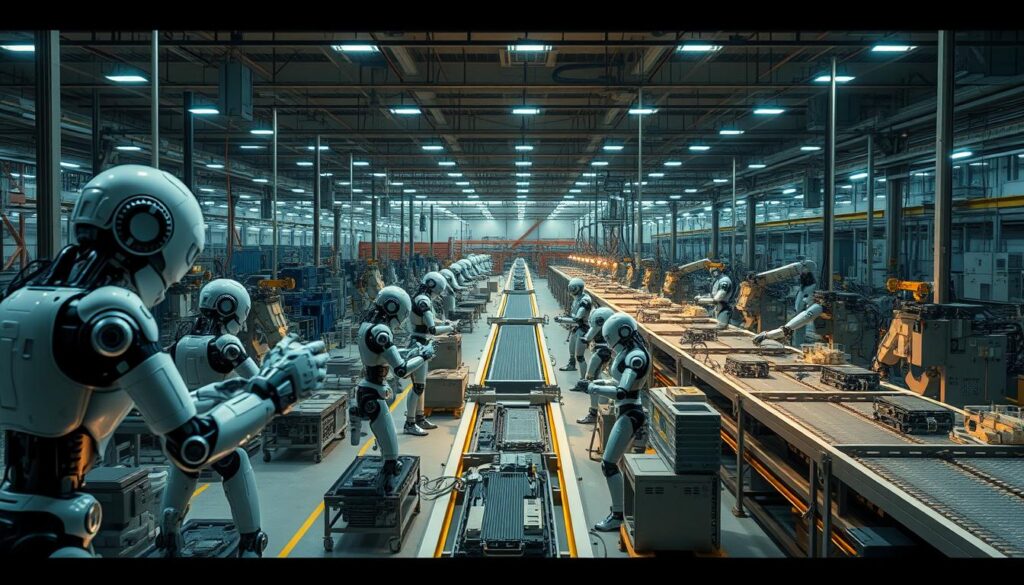“Artificial intelligence is the future, not only for Russia, but for all humankind,” said Vladimir Putin. This statement rings true as technology evolves at an unprecedented pace. China’s rapid strides in artificial intelligence are reshaping the global landscape, leaving many in awe of its development capabilities.
Recent breakthroughs highlight how Chinese companies are pushing boundaries. For instance, DeepSeek’s AI model was developed in under two months for less than $6 million, a cost over 90% cheaper than similar models by major US tech firms1. This efficiency has disrupted the market, with Nvidia losing nearly $600 billion in value following the news1.
China’s dominance in machine learning research is undeniable. Between 2019 and 2023, 36.5% of high-impact research came from Chinese institutions, compared to 15.4% from the US2. Such advancements underscore the intense competition between the two nations, with China leading in 57 out of 64 cutting-edge technology areas2.
As the world watches, it’s clear that artificial intelligence is not just a race but a transformative force. For more insights, explore this detailed analysis.
Key Takeaways
- China’s AI models are developed faster and cheaper than US counterparts.
- DeepSeek’s breakthrough cost under $6 million, disrupting the market.
- Chinese institutions lead in high-impact machine learning research.
- China surpasses the US in 57 out of 64 cutting-edge technology areas.
- AI advancements are reshaping global competition and industry trends.
China’s Explosive AI Surge

Chinese firms are leading the charge in AI innovation and development. The market is booming, with startups and established companies driving rapid advancements. This surge is fueled by significant government support and strategic investment in cutting-edge technologies.
In 2024, Tencent reported a 90% increase in net profits, reaching 51.3 billion yuan ($7.1 billion)3. Their revenue also rose by 11%, exceeding forecasts3. Such growth highlights the impact of AI enhancements in advertising, gaming, and video engagement3.
Alibaba plans to invest over $50 billion in AI and cloud computing over the next three years3. This commitment underscores the competitive edge Chinese companies are building. DeepSeek’s chatbot, launched in early 2025, further intensified this competition3.
Government initiatives have played a crucial role. Policies promoting research and development have created a fertile ground for innovation. Chinese institutions now lead in high-impact machine learning studies, outpacing global counterparts4.
The market dynamics are shifting. With scalable investment and robust research frameworks, China is solidifying its position as an AI powerhouse. This explosive growth is reshaping industries and setting new benchmarks globally.
The Shocking Truth About China’s AI Advancements!

Global competition in artificial intelligence is intensifying, with China making unprecedented strides. Recent developments reveal how Chinese firms are outpacing their counterparts in the united states, raising concerns about national security and technological dominance5.
DeepSeek, a Chinese startup, trained its AI model using between 2,000 to 50,000 Nvidia A100 chips, leveraging a stockpile acquired before US export restrictions5. In contrast, leading models in the West rely on an estimated 16,000 specialized chips5. This efficiency highlights China’s ability to innovate despite limited resources.
The chip industry plays a pivotal role in this race. DeepSeek’s model was developed in less than two months at a cost of under $6 million, significantly lower than the multibillion-dollar budgets of US tech giants6. This cost-effectiveness has disrupted the market, with Nvidia losing nearly $600 billion in value following the news6.
China’s advancements are not just about technology but also national security. The US government has imposed semiconductor restrictions, limiting China’s access to the most powerful chips7. However, these measures have forced Chinese companies to innovate, achieving remarkable results with less advanced hardware7.
As the world watches, the implications of China’s AI surge are far-reaching. From reshaping global markets to influencing security policies, these developments are setting new benchmarks. For more insights on cutting-edge AI tools, explore this detailed analysis.
Examining the Economic Impact on Global Tech

Economic shifts in the global tech industry are reshaping market dynamics. Government funding and strategic investments are driving innovation, while export controls and cost challenges are influencing competition. These factors are redefining the economy of technology on a global scale.
Government Investments and Funding
China’s planned 10 trillion yuan investment in technology highlights its commitment to innovation8. This funding supports research and development, enabling companies to achieve cost efficiencies. For example, DeepSeek’s AI model was developed for under $6 million, a fraction of the price of similar Western models8.
Such investments are not limited to China. The U.S. allocated $717 billion for defense, with significant funds directed toward AI-driven technologies9. These efforts reflect the growing importance of control over technological advancements in national strategies.
Market Expansion and Competition
Market dynamics are shifting as companies adopt innovative pricing strategies. DeepSeek’s advancements, for instance, disrupted the U.S. stock market, resulting in a $1 trillion loss8. This highlights the ability of cost-effective solutions to reshape industries.
Export controls also play a critical role. The U.S. imposed restrictions on advanced semiconductors, limiting China’s access to essential components9. Despite these challenges, Chinese firms continue to innovate, demonstrating resilience and adaptability.
| Factor | Impact |
|---|---|
| Government Funding | Drives innovation and cost efficiencies |
| Export Controls | Influences market competition and supply chains |
| Pricing Strategies | Reshapes business models and market dynamics |
These developments underscore the importance of control over technology and resources. As the global economy evolves, the ability to adapt and innovate will determine success in the tech industry.
Technology and Innovation Driving the AI Race

The fusion of hardware and software innovation is accelerating China’s AI race. Breakthroughs in chip technology and machine learning are propelling the nation ahead of global competitors. These advancements are reshaping industries and setting new benchmarks.
Breakthrough Chinese AI Models
DeepSeek’s R1 model, trained at a fraction of the cost compared to OpenAI’s similar model, has disrupted the market10. This efficiency highlights China’s ability to innovate despite limited resources. The model’s success underscores the nation’s strategic investment in cutting-edge technologies.
Another example is SenseRobot, which has sold over 100,000 chess-playing robots11. The cost of producing the robotic arm was reduced from $40,000 to $1,000 through AI integration11. Such breakthroughs demonstrate China’s advantage in cost-effective innovation.
Emerging Startups and Success Stories
China boasts over 4,500 firms developing and selling AI technologies11. Among them, DeepSeek, Unitree Robotics, and BrainCo are leading the charge. These startups are leveraging strategic investment to gain a competitive edge.
For instance, DeepSeek’s R1 achieved the No.1 spot on the App Store, reflecting its market impact10. Such success stories highlight how emerging firms are driving China’s AI revolution. Explore more on AI innovations in finance.
China’s commitment to AI is evident in its planned 10 trillion yuan investment over the next 15 years11. This funding supports research and development, enabling companies to achieve remarkable results. With such strategic backing, China is solidifying its position as a global leader in AI.
Strategic National Goals and Policy Support

Strategic national goals are shaping the future of technological innovation. China’s comprehensive development agenda is driven by ambitious targets and robust policy frameworks. These efforts aim to solidify its position as a global leader in cutting-edge technologies.
China’s 2030 Technology Ambitions
In 2017, China declared artificial intelligence a cornerstone of its economic transformation strategy through its Next Generation AI Development Plan. The goal is to establish itself as the global leader in AI by 203012. This plan includes significant investments in domestic chip production and AI model refinement.
China’s annual military expenditure on AI is estimated in the “low billions” of U.S. dollars, comparable to U.S. efforts12. Such funding underscores the nation’s commitment to advance its technological capabilities. The U.S. imposed trade restrictions to limit China’s access to critical AI-related technologies, particularly advanced semiconductors12.
Policy Measures and Regulatory Frameworks
Government initiatives play a pivotal role in fostering innovation. China’s policy measures include substantial funding and regulatory support for research and development. For instance, DeepSeek’s large language model, released in January 2025, surpassed models from prominent U.S. companies in performance and cost efficiency12.
DeepSeek reportedly has a total of 50,000 Hopper generation GPUs, including H100s, H800s, and H20s13. This infrastructure supports its advance in AI capabilities. The U.S. National AI Initiative Act of 2020 prioritized five key objectives to bolster its AI capabilities12.
| Policy Measure | Impact |
|---|---|
| Next Generation AI Development Plan | Establishes China as a global AI leader by 2030 |
| Military Expenditure on AI | Comparable to U.S. investments, driving innovation |
| Trade Restrictions | Limits access to critical technologies, prompting local solutions |
These strategies highlight how government support and resource access are transforming the technological landscape. China’s commitment to AI is evident in its planned 10 trillion yuan investment over the next 15 years12. This funding ensures sustained growth and innovation in the sector.
AI Revolution in Consumer Applications

AI-powered devices are transforming how we live and interact daily. From smart homes to personal assistants, these innovations are making life more convenient and efficient. The integration of sophisticated models into everyday products is reshaping the consumer tech landscape.
Smart Home and Personal Robotics
Smart home devices, powered by AI, are becoming essential in modern households. Voice-activated assistants like Alexa and Google Home use advanced language processing to manage tasks. Personal robotics, such as cleaning robots, rely on AI models to navigate and adapt to their environment14.
DeepSeek’s R1 model, developed for just $5.6 million, showcases how cost-effective AI can be14. This tech is now integrated into consumer gadgets, making them smarter and more accessible. The industry is leveraging talent to create devices that enhance daily routines.
Integration of AI in Daily Life
AI is seamlessly blending into everyday activities. From fitness trackers to smart thermostats, these devices use research advancements to improve functionality. For example, AI-powered apps can now predict user preferences and automate tasks15.
DeepSeek’s chatbot, which became the most downloaded app in the U.S., demonstrates the growing demand for AI-driven solutions14. These innovations are not just about convenience but also about improving productivity and efficiency in daily life.
| Application | AI Feature |
|---|---|
| Smart Assistants | Voice recognition and task automation |
| Cleaning Robots | Navigation and adaptive cleaning |
| Fitness Trackers | Health monitoring and data analysis |
The consumer tech revolution is driven by industry leaders and talent who push the boundaries of innovation. As AI continues to evolve, its impact on everyday life will only grow, making it an integral part of our day-to-day experiences.
Data as the Fuel of AI Innovation

Data is the backbone of artificial intelligence, driving innovation and shaping the future of technology. Without vast amounts of datum, AI models cannot learn, adapt, or improve. This section explores how data powers AI advancements, the advantages of big data, and the challenges posed by privacy concerns and regulations.
The Big Data Advantage
Big data provides a significant edge in training and refining AI models. DeepSeek’s R1 model, for instance, was developed at a fraction of the cost compared to OpenAI’s offerings, thanks to efficient data utilization16. This cost-effectiveness highlights how datum can drive innovation even with limited resources.
NVIDIA’s stock dropped by 17% on January 27 due to fears of decreased demand for high-performance GPUs essential for AI training16. This shift underscores the growing reliance on data-driven solutions over hardware dependency. The integration of advanced chip technology further enhances data processing capabilities, making AI models more efficient.
Privacy Concerns and National Regulations
Privacy concerns are a major issue in data collection for AI. Governments worldwide are implementing strict regulations to ensure security and protect user information. For example, the U.S. strategy of export controls limits China’s access to advanced chips, forcing local firms to innovate with less powerful hardware16.
These measures aim to balance control over data usage with the need for innovation. However, they also raise concerns about the scalability of AI industries in regions facing such restrictions. DeepSeek’s advancements demonstrate that innovation can still occur despite these challenges16.
| Factor | Impact |
|---|---|
| Big Data | Enhances AI model training and efficiency |
| Privacy Regulations | Shapes data collection methods and security |
| Chip Technology | Improves data processing and AI capabilities |
The interplay between data, security, and innovation is reshaping the AI landscape. As concerns over privacy grow, finding a balance between regulation and progress will be crucial for future advancements.
National Security Implications of AI Advancements

The race for AI dominance is intensifying geopolitical tensions worldwide. Rapid advancements in artificial intelligence are reshaping global power dynamics, with significant implications for national security. As China accelerates its AI capabilities, the united states faces mounting challenges in maintaining its technological edge.
US-China Tensions in Tech and Data
Geopolitical tensions between the united states and China are escalating due to AI-driven innovations. DeepSeek, a Chinese startup, developed a large language model in just two months at a cost of under $6 million, disrupting the market17. This efficiency has raised concerns about the power balance in the global tech race.
The U.S. government has responded with measures to protect its interests. For instance, the National Security Agency established the Artificial Intelligence Security Center to counter threats from foreign AI programs17. Such initiatives highlight the growing importance of national security in the AI race.
Government Oversight and Power Dynamics
Government oversight plays a critical role in shaping AI strategies. The U.S. government has allocated significant resources to AI-driven technologies, including a $500 billion initiative termed Stargate AI17. These efforts aim to maintain power and intelligence superiority in the face of Chinese advancements.
Meanwhile, China’s national intelligence law mandates that all enterprises and citizens support national intelligence efforts18. This policy framework strengthens China’s position in the global race for AI dominance, further intensifying tensions with the united states.
| Factor | Impact |
|---|---|
| DeepSeek’s Efficiency | Disrupts market dynamics and raises security concerns |
| U.S. Government Initiatives | Strengthens national security and technological edge |
| China’s Intelligence Law | Enhances domestic AI capabilities and global influence |
As the race for AI supremacy continues, the interplay between national security, government oversight, and intelligence strategies will shape the future of global power dynamics. The stakes are high, and the outcomes will redefine international relations in the years to come.
Competitiveness of Chinese AI Enterprises

Innovative strategies by Chinese companies are setting new benchmarks in AI development. Firms like DeepSeek are leading the charge, reshaping the global market with cost-effective and efficient solutions. Their advancements are not only challenging established players but also redefining the tech landscape.
DeepSeek and the Chatbot Revolution
DeepSeek’s R1 reasoning model, developed for just $5.6 million, rivals the performance of OpenAI’s o1 model at a fraction of the cost19. This breakthrough highlights the advantage Chinese firms have in leveraging algorithmic advances to reduce training costs. Last year, DeepSeek’s chatbot became a global sensation, showcasing the company’s ability to innovate despite resource constraints20.
DeepSeek’s models also show fewer signs of built-in censorship, offering a more open approach compared to hosted models19. This flexibility has allowed the firm to gain a competitive edge in international markets. Their success underscores the transformative impact of Chinese AI innovations on the industry.
Profiles of Leading Chinese AI Firms
Beyond DeepSeek, other Chinese companies are making significant strides. For instance, SenseRobot has integrated AI into robotics, reducing production costs dramatically19. Another leader, BrainCo, focuses on AI-driven neurotechnology, pushing the boundaries of human-machine interaction.
These firms are not just competing locally but are also expanding their influence globally. Their strategic investment in research and development has enabled them to outperform international competitors in key tech areas. This growth trajectory positions China as a dominant force in the AI market.
| Company | Innovation | Impact |
|---|---|---|
| DeepSeek | Cost-effective AI models | Disrupted global chatbot market |
| SenseRobot | AI-integrated robotics | Reduced production costs by 90% |
| BrainCo | Neurotechnology advancements | Enhanced human-machine interaction |
Chinese AI enterprises are leveraging their advantage in cost efficiency and innovation to secure a leading position in the global market. Their ability to adapt and innovate ensures they remain at the forefront of the tech revolution.
The Race Between China and the United States

The global AI landscape is witnessing a fierce competition between two superpowers, each vying for dominance in innovation and market influence. This race is not just about technological superiority but also about shaping the future of global leadership in artificial intelligence.
Comparative Global Market Strategies
China’s Next Generation AI Development Plan, launched in 2017, aims to position the country as the global leader in AI by 203021. This ambitious strategy includes significant investments in smart manufacturing, autonomous vehicles, and healthcare, driving economic growth and global influence21.
In contrast, the united states has prioritized AI development through initiatives like the National AI Initiative Act of 2020. This act focuses on enhancing research, optimizing federal resources, and fostering international collaborations21. The U.S. also leads in foundational breakthroughs, with institutions like MIT and Stanford pioneering neural networks and deep learning22.
Leadership and Export Policies
Leadership styles play a crucial role in shaping AI strategies. CEOs of major tech firms in both countries are driving innovation, but their approaches differ. Chinese firms like DeepSeek have leveraged cost-effective solutions, while U.S. companies focus on cutting-edge research and development21.
Export restrictions have also influenced the race. The U.S. imposed trade controls to limit China’s access to advanced semiconductors, prompting Chinese firms to innovate with less powerful hardware21. Despite these challenges, China’s centralized guidelines have streamlined AI deployment, giving it a strategic advantage22.
As the competition intensifies, smaller nations are increasingly aligning with either the U.S. or China, contributing to the fragmentation of the global AI ecosystem21. This dynamic underscores the importance of leadership and strategy in shaping the future of AI. For more insights on how AI is transforming business, explore this detailed analysis.
Fusion of AI and Robotics in Manufacturing

Manufacturing is undergoing a seismic shift as robotics and artificial intelligence merge to redefine production processes. This integration is not just enhancing efficiency but also driving significant cost reductions. Companies worldwide are leveraging these advances to stay competitive in an increasingly automated market.
Artificial Engineering Transforming Production
Artificial engineering is at the forefront of this transformation. For instance, Chinese firms have reduced production costs dramatically by integrating AI into robotics. SenseRobot, for example, cut the cost of producing a robotic arm from $40,000 to $1,00023. This efficiency is reshaping industries, making advanced manufacturing accessible to more firms.
Computing power and chip technology play a pivotal role in these advancements. Enhanced processing capabilities allow robots to perform complex tasks with precision. This has led to a surge in demand for high-performance chips, driving innovation in the semiconductor industry.
Cost Efficiency and Innovation in Robotics
Cost efficiency is a key driver of innovation in robotics. Companies like DeepSeek have developed AI models at a fraction of the cost compared to Western counterparts24. This cost-effectiveness is enabling smaller firms to adopt advanced technologies, leveling the playing field in global markets.
Moreover, the integration of AI and robotics is reducing labor costs. China’s labor costs are approximately 25 to 30 percent of U.S. costs, providing a significant advantage24. This has allowed Chinese companys to scale production while maintaining profitability.
Leading companys are adopting these innovations to stay ahead. For example, Xiaomi unveiled CyberOne, a humanoid robot designed for manufacturing applications23. Such advances are not only improving production efficiency but also setting new standards for the industry.
Educational and Talent Development for AI Excellence

Education systems worldwide are evolving to meet the demands of a technology-driven future. In this race for innovation, talent development has become a critical focus. Countries are investing heavily in STEM education to ensure they remain competitive in the global technology landscape.
STEM Education and University Initiatives
Universities are at the forefront of this transformation. Institutions like Tsinghua University in China are leading the charge, offering specialized programs in AI and machine learning. These initiatives aim to bridge the gap between academic research and industry needs.
Recent studies show a 14% increase in university applications for engineering and technology courses25. This surge reflects the growing recognition of STEM fields as essential for future innovation. Programs that combine theoretical knowledge with practical applications are producing graduates ready to tackle real-world challenges.
Cultivating Future Tech Leaders
Beyond formal education, programs are being designed to cultivate future tech leaders. Mentorship initiatives, hackathons, and industry partnerships are providing students with hands-on experience. These efforts are crucial for developing the next generation of innovators.
For example, DeepSeek’s focus on research and technology has set a new benchmark for AI development26. Their success highlights the importance of fostering talent that can drive innovation. By addressing the challenges of AI, these programs are ensuring that the country remains a leader in the field.
Educational models are also evolving to meet future demands. Personalized learning approaches, like tutoring, have shown significant improvements in student achievement25. Such methods are essential for preparing students to excel in a rapidly changing technology landscape.
As the world continues to embrace AI, the role of education and talent development cannot be overstated. For more insights on how AI is transforming learning, explore this detailed analysis.
US Perspectives on Chinese AI Advancements
As China accelerates its AI capabilities, the united states faces mounting challenges in maintaining its technological edge. Concerns over national security and data privacy are driving policy debates, with the U.S. government implementing measures to counter Chinese advancements27.
National Security and Data Privacy Concerns
The U.S. has introduced export controls to limit China’s access to high-end semiconductors, aiming to maintain a technological gap27. Despite these efforts, Chinese firms like DeepSeek have found ways to innovate, producing advanced models at a fraction of the cost28.
Data privacy is another critical issue. The U.S. government is tightening regulations to protect sensitive information from foreign access. These measures are part of a broader strategy to safeguard national interests in the AI race16.
Policy and Competitive Responses
In response to China’s progress, the U.S. has launched initiatives like the National AI Initiative Act of 2020. This act focuses on enhancing research and fostering international collaborations27. The goal is to ensure the united states remains a leader in AI innovation.
Export restrictions have also been a key tool. The U.S. aims to keep at least 50% of its compute base within its borders for large frontier model training27. These policies reflect a strategic effort to maintain control over critical technologies.
For more insights into how AI companies are shaping the future, explore this detailed analysis.
Future Implications and Emerging AI Trends
The rapid evolution of artificial intelligence is reshaping industries and economies worldwide. As we look ahead, next-generation innovations and global economic shifts are set to redefine the market landscape. These advancements will not only transform how businesses operate but also influence international competitiveness.
Next-Generation Technological Innovations
Emerging technologies are pushing the boundaries of what AI can achieve. In 2017, China declared AI a cornerstone of its economic transformation strategy through its Next Generation AI Development Plan, aiming to establish itself as the global leader in AI by 203029. This ambitious goal has spurred significant investments in smart manufacturing, autonomous vehicles, and healthcare.
Companies are leveraging AI to drive efficiency and innovation. For instance, 77% of companies are either using or exploring the use of AI in their businesses30. This trend highlights the growing importance of AI in maintaining a competitive edge. The integration of AI into robotics, as seen with SenseRobot, has reduced production costs dramatically, making advanced manufacturing accessible to more firms29.
Prospective Global Economic Shifts
AI advancements are also reshaping global economic power dynamics. The united states and China are engaged in a high-stakes competition over AI, which poses risks to global stability and security29. This rivalry is compelling nations to adapt their strategies in response to the evolving landscape.
AI is projected to contribute $15.7 trillion to the global economy by 203030. This growth will be driven by increased productivity and the creation of new jobs. By 2025, AI might eliminate 85 million jobs but create 97 million new ones, resulting in a net gain of 12 million jobs30. These shifts underscore the transformative potential of AI on a global scale.
For more insights on how AI is transforming industries, explore this detailed analysis.
Conclusion
China’s rapid strides in technology are reshaping global dynamics, with innovations that challenge traditional leaders. Key datum points highlight how Chinese firms like DeepSeek achieve cost-effective breakthroughs, outperforming competitors in the united states31. This progress is fueled by robust government support and strategic investments in tech sectors.
Export dynamics play a crucial role, with China leveraging its country-specific advantages to dominate global markets. For instance, Taiwan’s exports to the U.S. surged by 46%, reflecting the growing demand for tech components31. These trends underscore the shifting balance of power in the world’s technological landscape.
Looking ahead, the number of advancements in AI and robotics will continue to shape industries. To stay competitive, nations must adapt to these changes. For deeper insights into China’s AI strategy, explore this detailed analysis.
FAQ
How is China advancing in artificial intelligence?
What role does data play in China’s AI development?
How does China’s AI growth impact global markets?
What are the national security concerns with China’s AI advancements?
How is China developing AI talent?
What are the future trends in China’s AI industry?
Source Links
- Everything you need to know about China’s AI, DeepSeek
- Could’ve seen it coming: ASPI’s tech tracker had picked up China’s AI strength | The Strategist
- China’s Tencent sees profits surge as AI drive accelerates
- China’s Overlooked AI Energy Edge Over the US: Cheaper Energy
- DeepSeek: How China’s ‘AI heroes’ overcame US curbs to stun Silicon Valley
- What’s DeepSeek, China’s AI startup sending shockwaves through global tech?
- How China’s new AI model DeepSeek is threatening U.S. dominance
- China’s AI breakthroughs show how it is outcompeting Western monopoly capitalism – Geopolitical Economy Report
- AI Rivalries: Redefining Global Power Dynamics
- US Tech Companies Embrace AI ‘Arms Race’ With China – and the Money It Brings
- From chatbots to intelligent toys: How AI is booming in China
- AI Rivalries: Redefining Global Power Dynamics
- DeepSeek, Huawei, Export Controls, and the Future of the U.S.-China AI Race
- A Compelling Opportunity to Diversify From U.S. Stocks
- China’s AI leap demands a Manhattan Project-level Western response
- DeepSeek’s Latest Breakthrough Is Redefining AI Race
- The Alarming National Security Implications of DeepSeek and China’s A.I. Breakthrough
- Experts urge caution over use of Chinese AI DeepSeek
- What DeepSeek Really Changes About AI Competition
- ‘Game on’: Tech execs say DeepSeek ramps up China-U.S. competition but won’t hurt OpenAI
- AI Rivalries: Redefining Global Power Dynamics
- U.S.-China AI Cold War Is Heating Up—Can OpenAI’s Stargate End It?
- The Physical AI Revolution Part 1: The Long Road to Humanoid Robotics
- China Is Rapidly Becoming a Leading Innovator in Advanced Industries
- The Skinny on AI for Education #13 | Professor Rose Luckin’s EDUCATE Ventures Research | AI for Education
- Deepseek: The Quiet Giant Leading China’s AI Race
- Silent Saboteurs: Loaded Assumptions in US AI Policy
- What DeepSeek Revealed About the Future of U.S.-China Competition
- AI Rivalries: Redefining Global Power Dynamics
- 131 AI Statistics and Trends for (2024) | National University
- Taking Stock of the DeepSeek Shock







